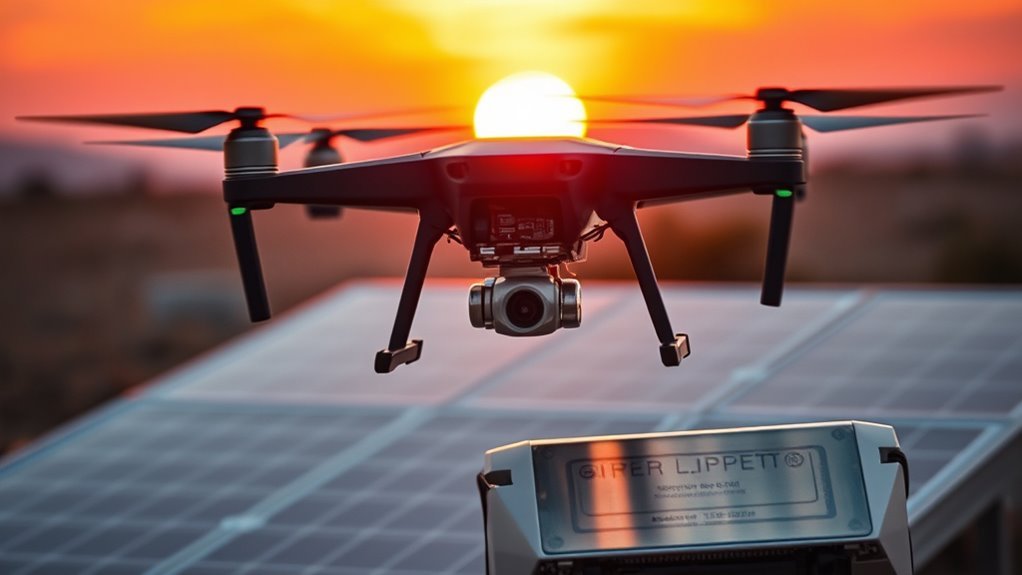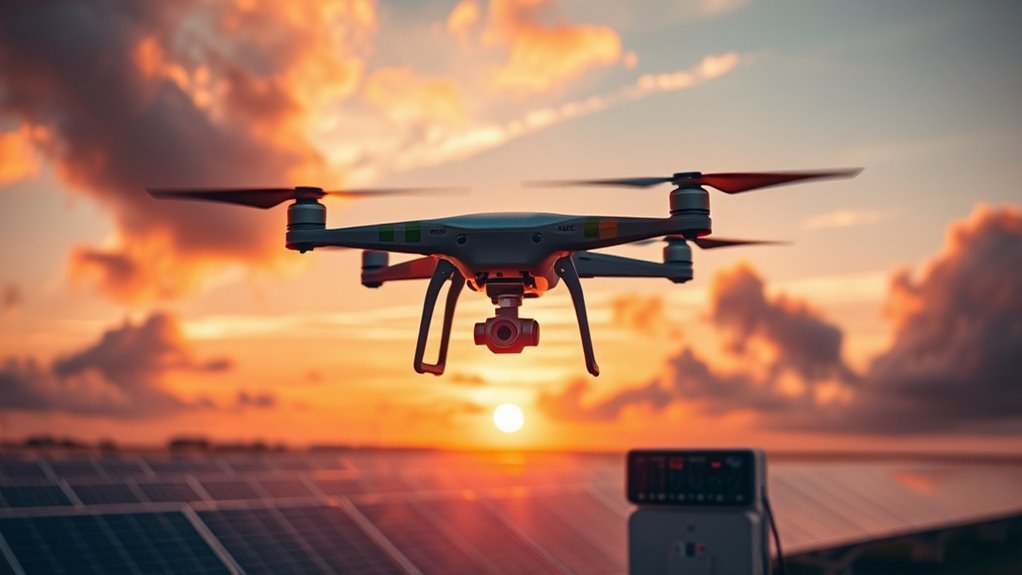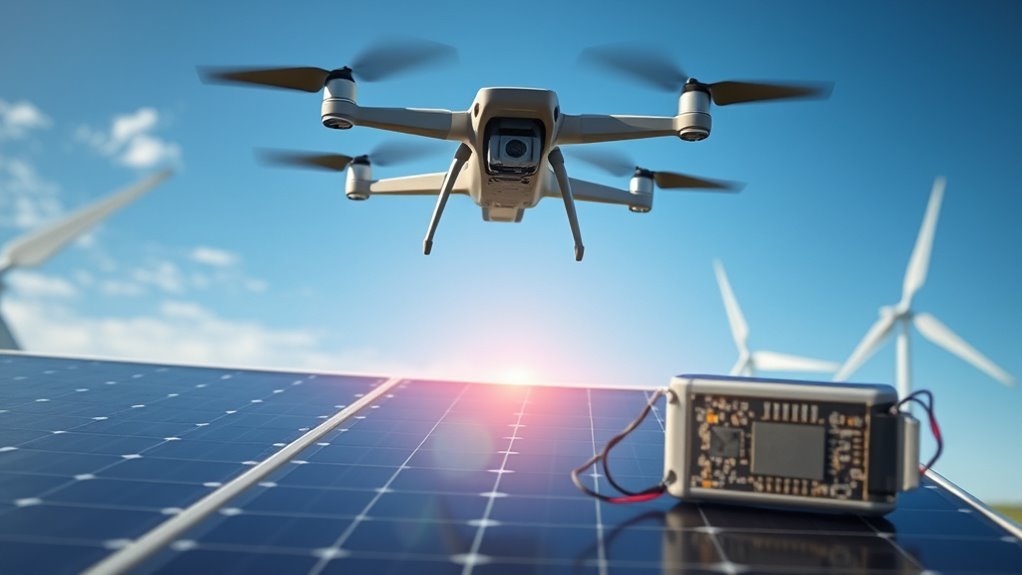Drones are powered by various energy sources, including lithium-ion batteries, fuel cells, and solar power. Lithium-ion batteries are the most common due to their high energy density and lightweight properties, offering extended flight times. Fuel cells provide longer ranges with cleaner emissions, while solar panels can enhance flight duration under ideal conditions. Each energy source has distinct advantages and challenges affecting drone performance. Understanding these options can improve drone operations, and exploring emerging innovations will reveal even more capabilities.
Overview of Drone Power Requirements

Drones depend on specific power requirements to function effectively, and understanding these needs is vital for optimizing their performance. The energy efficiency of a drone considerably influences its operational capabilities, including flight time and payload capacity. For instance, a drone’s motor power, battery capacity, and weight all play important roles in how effectively it can convert energy into flight. By analyzing these factors, you can identify ways to enhance drone performance, such as selecting lightweight materials or optimizing flight paths for reduced energy consumption. Additionally, understanding the interplay between power demands and environmental conditions allows you to maximize operational freedom while minimizing limitations. Prioritizing energy efficiency not only improves performance but also extends the drone’s operational range, empowering you to achieve more in your missions. Furthermore, employing advanced AI integration can streamline energy management systems, ensuring that drones operate at peak efficiency. The incorporation of advanced collision avoidance features enhances operational safety while managing energy consumption effectively.
Types of Energy Sources for Drones

Understanding drone power requirements naturally leads to exploring the various energy sources that can fuel these systems. When considering energy efficiency and the advancements in battery technology, you’ll find several viable options:
- Lithium-based Batteries: These are popular due to their high energy density and lightweight properties, which enhance flight duration. Additionally, advancements in battery life have significantly improved the performance of drones like the Intel Shooting Star 2.
- Solar Panels: Utilizing solar energy can extend flight times, particularly for drones designed for longer missions or stationary use.
- Hydrogen Fuel Cells: While less common, hydrogen fuel cells offer a promising alternative with potential for higher energy output and shorter refueling times. The high-capacity lithium-polymer battery design ensures stable power output and contributes to longer flight times.
Each energy source presents unique advantages and challenges. As you explore these options, understanding their implications on performance and environmental impact will empower your drone operations.
Lithium-Ion Batteries: The Most Common Choice

While there are various energy sources available for drones, lithium-ion batteries remain the most prevalent choice in the industry. Their high energy density allows drones to achieve extended flight times, addressing the critical need for battery longevity. You’ll find that these batteries can be recharged numerous times, making them cost-effective in the long run. However, to maximize their efficiency, a robust charging infrastructure is essential. This includes fast chargers and standardized connectors, enabling quick turnaround times between flights. The combination of advanced battery technology and reliable charging systems empowers you to operate drones with greater freedom, whether for recreational use or commercial applications. Ultimately, lithium-ion batteries balance performance and practicality, simplifying energy management in the drone sector. Furthermore, the flight time and performance of drones heavily relies on the efficiency of these batteries, influencing their overall capabilities. For instance, the DJI Mavic 3 Enterprise utilizes high-density lithium-polymer cells to enhance energy storage and extend flight time.
Fuel Cells: A Promising Alternative
Fuel cells represent a transformative shift in energy sources for drones, offering distinct advantages over traditional lithium-ion batteries. You’ll find that fuel cell technology not only enhances operational efficiency but also extends flight durations considerably. As we explore the future of fuel cells, you’ll see their potential to reshape the drone industry.
Fuel Cell Technology Overview
As the demand for efficient and sustainable energy sources grows, fuel cell technology emerges as a promising alternative for powering drones. This technology harnesses chemical energy to produce electricity, offering several key advantages:
- Fuel Cell Efficiency: Fuel cells convert hydrogen and oxygen directly into electricity with high efficiency, often surpassing traditional combustion engines.
- Hydrogen Storage: Advanced methods for hydrogen storage are critical, enabling drones to operate for extended periods without frequent refueling.
- Environmental Impact: Fuel cells emit only water vapor as a byproduct, contributing to cleaner aerial operations.
Advantages of Fuel Cells
Fuel cells represent a notable advancement in drone technology, providing numerous advantages that enhance operational efficiency and sustainability. Their fuel cell efficiency far surpasses traditional battery systems, allowing for longer flight times and reduced downtime. This efficiency translates to more effective missions, enabling you to cover greater distances without frequent recharging. Additionally, fuel cells generate minimal emissions, considerably lowering the environmental impact compared to fossil fuels. As a result, adopting fuel cells aligns with the growing demand for eco-friendly solutions in aviation. By choosing fuel cell-powered drones, you’re not only improving performance but also contributing to a more sustainable future. This combination of efficiency and reduced ecological footprint makes fuel cells a compelling choice for the modern drone operator.
Future of Fuel Cells
While many energy sources are vying for dominance in drone technology, fuel cells stand out as a promising alternative for the future. With ongoing fuel cell advancements, the potential for drones powered by hydrogen is becoming increasingly viable. Here are three key considerations:
- Efficiency: Fuel cells convert hydrogen into electricity with high efficiency, reducing energy loss compared to traditional batteries.
- Hydrogen Storage: Innovations in hydrogen storage solutions are essential, enabling longer flight times and greater range for drones.
- Environmental Impact: Fuel cells produce only water vapor as a byproduct, aligning with growing demands for sustainable energy solutions.
As these technological developments progress, fuel cells could redefine drone operations, offering you the freedom to explore new applications and capabilities without environmental compromise.
Solar Power: Harnessing the Sun for Flight
When considering solar power for drones, you need to focus on the efficiency of solar panels and their impact on flight duration. Higher efficiency panels can greatly extend operational time by maximizing energy capture from sunlight. This capability not only enhances mission profiles but also reduces the need for frequent recharging.
Solar Panel Efficiency
As advancements in solar technology continue to evolve, the efficiency of solar panels plays an essential role in enhancing drone capabilities and extending flight durations. To maximize the potential of solar-powered drones, consider the following:
- Solar Panel Materials: The choice of materials, such as monocrystalline or polycrystalline silicon, considerably affects energy absorption.
- Solar Efficiency Metrics: Understanding conversion rates, expressed as a percentage of sunlight converted to electricity, is vital for evaluating performance.
- Environmental Factors: Factors like temperature, shading, and angle of exposure can impact overall efficiency, necessitating strategic design considerations.
These elements together shape the future of solar-powered drones, allowing for greater autonomy and flexibility in applications while harnessing the freedom of renewable energy.
Flight Duration Extension
By leveraging solar power, drones can greatly extend their flight duration, making them more efficient for a variety of applications. This technology enhances battery longevity and optimizes energy management, allowing drones to operate longer without frequent recharges. By integrating solar panels into their designs, drones can harness sunlight during flight, converting it into usable energy.
| Aspect | Impact on Flight Duration |
|---|---|
| Battery Longevity | Increased by utilizing solar energy |
| Energy Management | More efficient power distribution |
| Flight Applications | Expands range and functionality |
Incorporating solar energy not only prolongs operational time but also offers a sustainable solution, aligning with the desire for freedom in drone operation. Embracing solar technology, you can reveal new horizons in drone capabilities.
Hybrid Systems: Combining Power Sources
Hybrid systems, which integrate multiple energy sources, represent a considerable advancement in drone technology. By utilizing hybrid propulsion, these systems enhance energy efficiency, allowing for longer flight durations and greater operational flexibility. Here are three key benefits of hybrid systems:
Hybrid systems revolutionize drone technology, offering enhanced energy efficiency for extended flight durations and increased operational flexibility.
- Extended Range: Combining battery power with fuel sources can considerably extend a drone’s operational range. This innovation is similar to how DJI Air 3S optimizes its performance with superior battery life.
- Improved Performance: Hybrid propulsion balances power output, providing the necessary thrust while optimizing energy consumption.
- Reduced Emissions: By integrating cleaner energy sources, hybrid systems contribute to lower overall emissions, supporting environmental sustainability.
Moreover, these advancements in AI integration not only meet the demands of diverse applications but also align with a desire for greater autonomy and operational freedom in drone technology.
Advantages and Disadvantages of Each Energy Source
The exploration of energy sources for drones reveals a variety of options, each with its own set of advantages and disadvantages. Electric batteries, for instance, offer efficient energy storage and low environmental impact, but their limited flight time can be a significant drawback. Fuel cells provide longer ranges and faster refueling, yet they typically involve complex systems that can increase weight and cost. Solar energy harnesses the sun, extending flight duration, but relies heavily on weather conditions and surface area for efficiency. Additionally, battery efficiency in models like the DJI Matrice 600 demonstrates how advancements in drone technology can enhance operational capabilities. Hybrid systems combine these benefits, yet can complicate maintenance. Ultimately, your choice of energy source hinges on balancing performance needs against environmental considerations and operational constraints, ensuring that freedom of use aligns with sustainability goals. Furthermore, advancements in drone technology, such as the longest flight times showcased by models like the DJI Mavic 3 Pro, further emphasize the importance of energy efficiency in maximizing operational capabilities.
Innovations in Drone Power Technology
As advancements in technology continue to unfold, innovations in drone power systems are reshaping the landscape of aerial operations. You’ll find that drone battery advancements and energy efficiency innovations are at the forefront of these changes. Here are three key innovations to evaluate:
- Solid-State Batteries: These offer higher energy density, reducing weight while increasing flight time. Additionally, Coretronic’s innovations in battery technology could significantly enhance the operational efficiency of their drones.
- Solar Power Integration: Utilizing solar panels enhances energy capture, extending operational range without frequent recharges.
- Regenerative Energy Systems: Capturing energy during descent or maneuvering contributes to overall efficiency and sustainability.
These innovations not only enhance drone performance but also empower you to explore new capabilities, ultimately expanding the horizons of what drones can achieve in various applications. Additionally, the potential US ban on DJI could drive innovation in the drone sector, as competing firms strive to fill the gaps left by DJI’s absence.
Future Trends in Drone Energy Solutions
With the rapid advancements in drone power technology, future energy solutions are set to transform aerial operations even further. Energy storage innovations, such as advanced lithium-sulfur batteries and ultracapacitors, will enhance flight duration and efficiency. These technologies promise to reduce weight while increasing energy density, enabling longer missions without compromising payload capacity. Additionally, sustainable fuel advancements, including biofuels and hydrogen fuel cells, will provide eco-friendly alternatives to traditional fossil fuels. This shift not only aligns with global sustainability goals but also offers operational flexibility for various applications. As you explore these trends, consider how they can empower your drone operations, enhancing your autonomy while minimizing environmental impact. The future of drone energy solutions is promising, offering unprecedented possibilities for freedom in the skies. Furthermore, innovations in AI-driven navigation are likely to enhance the efficiency of energy use in drones, optimizing routes and reducing flight times. In addition, predictive maintenance technologies will ensure that drones operate at peak performance, further extending their operational capabilities.
Frequently Asked Questions
How Long Do Drone Batteries Typically Last During Flight?
Imagine a bird soaring through the sky; drone batteries typically last 20 to 30 minutes during flight. This battery lifespan defines your flight duration, influencing how far and how freely you can explore.
Can Drones Be Powered by Renewable Energy Sources?
Yes, you can power drones with renewable energy sources like solar panels and wind turbines. Integrating these technologies can enhance flight duration and reduce dependence on conventional batteries, promoting sustainability in aerial operations.
What Factors Affect Drone Battery Life and Performance?
Did you know that a drone’s battery capacity can drop by 30% with just a 10% increase in flight weight? This highlights how essential weight management is for maximizing battery life and overall performance.
Are There Regulations for Drone Energy Sources?
Yes, there’re drone regulations governing energy compliance. You’ll need to guarantee your drone’s energy sources meet safety standards and environmental guidelines. Non-compliance could lead to legal repercussions, restricting your operational freedom in various airspaces.
How Do Weather Conditions Impact Drone Energy Efficiency?
Weather conditions greatly impact your drone’s energy efficiency. Wind resistance can decrease flight duration, while temperature effects influence battery performance. You’ll need to adapt your operations based on these variables to guarantee peak performance and freedom in flight.

